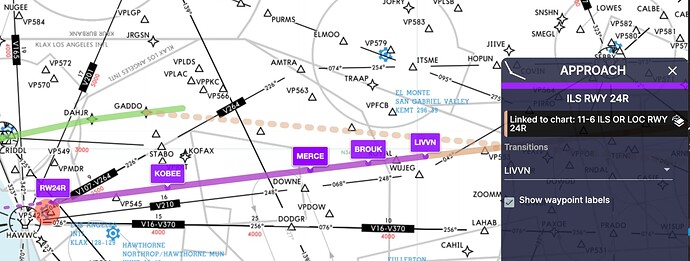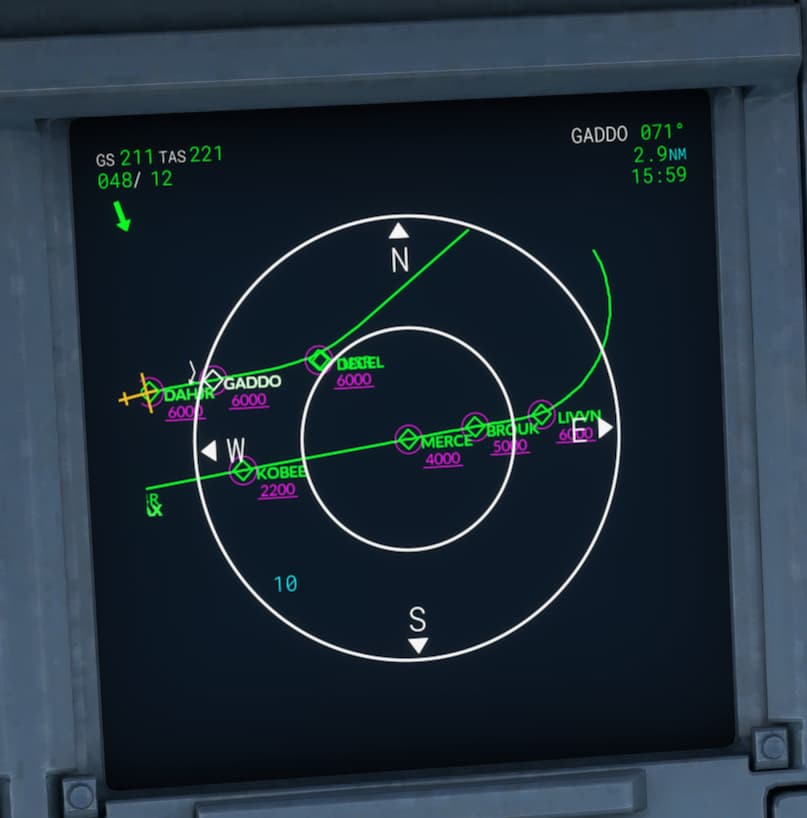So finally trying to get realistic and use SIDs and STARs using Navigraph.
I’m flying the route above, using the IRNMN2 STAR going south along the coast towards LAX, and landing on runway 24R. Right about at that airport, you turn left and go quite a ways eastward before turning back west to land. At the end of IRNMN2, fix DAHJR, the altitude restriction is exactly 6000 feet. But the altitude at the FAF for ILS 24R (SKOLL) is 10000 feet. Does this mean I’m supposed to descend to 6000 and then climb to 10000?
I believe the IRNMN2 arrival would normally be used to connect to the RNAV approach for 24R like below. For the ILS approach I believe you would chose a different STAR?
FAF for ILS 24R is KOBEE at 2200 ft, so that also works from IRNMN2. To fly the ILS you would get radar vectors from GADDO using some third-party ATC solution.
Without vectors I agree with @WasabiDad2405 that RNAV Z 24R is easier if the avionics in your aircraft supports it
If you have neither radar vectors nor an aircraft that can fly RNAV (RNP) approaches this is one of those rare cases where I might “self-vector” by viewing my location on a moving map and giving myself headings to fly that approximate realistic radar vectors until I can intercept the ILS. Or fly an entirely different STAR and approach, maybe something like DIRBY1 that drops you off at TRNDO which is an IAF for the ILS 25L.
SKOLL is not the FAF.
After reaching GADDO at 6000, notice what the STAR says about expecting vectors.
If you are coming in on the IRNMN2 it will drop you off at GADDO at 6000 and a track of 071. Both the ILS and RNAV approaches to 24R are valid approaches. Since you mentioned the ILS, I’ll stick with that, but the principle also applies to the RNAV approach. In most cases you will be joining an approach at an Initial Approach Fix (IAF). For the ILS 24R approach there are three of them; CRCUS, SEAVU and LIVVN. LIVVN is the most appropriate. Not only is it closer to where you are exiting the STAR, but it also has an assigned altitude of 6000 feet. There would be no reason for you to proceed out to either of the other two. You would never be joining an approach at the Final Approach Point (FAP) or the Final Approach Fix (FAF). Just to keep the terminology straight, FAPs are used for precision approaches and FAFs for non-precision approaches. What they have in common is that they are the points where you will begin your final descent to the Missed Approach Point (MAP).
In the real world, what would probably happen is that you would fly the 071 track from GADDO until you were sufficiently past LIVVN and ATC would tell you to “Turn right, heading 230, join the ILS 24R localizer”. The turn would be timed so that you joined the localizer outside LIVVN at a 30 degree intercept angle. That’s not an approach clearance. You can’t descend below 6000 at that point. At some point after LIVVN you would be cleared to descend so that you would cross MERCE at 4000. MERCE is the Initial Fix (IF) so after MERCE you would be cleared down to 2200 and cleared for the approach. KOBEE is the Final Approach Point (FAP) and the glideslope intercept point. Since you would be cleared for the approach at this point, you can begin your descent.
It’s pretty cool how they named the stars KOBEE and GIGI in memory of Kobe and Gigi. I heard it the first time on LiveATC a year ago. I’ve never heard LAX tower say those before their accident. I’m from LA/Orange County area so I tend to listen to KLAX frequency on LiveATC at times.
Two issues with that writeup:
- If you are on vectors there is no need to join the approach at an IAF. That is one of the main reasons for using vectors.
- If you are on vectors I doubt ATC would send you all the way out to LIVVN; they might, depending on traffic, but I suspect vectoring to look more similar to the RNAV Z 24R track - not because there is some particular reason for vectors to follow the RNAV track, but because they made the RNAV track similar to what the usual vector pattern is.
Wow, thanks for all the responses. I obviously still have a fair amount to learn, after flying several months basically navigating straight to approaches and ignoring SIDs/STARS.  I’ll absorb this better tonight, after my day job.
I’ll absorb this better tonight, after my day job.
Yes, I’ve noticed lots of cool Nav fixes all over the place. IIRC there was some route I found from maybe Columbus OH to Dulles that had fixes named something like “911-NEVR-FORGT” or similar…I’ll have to look for that again.
That’s why I said “in most cases”. There are times when you can join an approach from the IF but there a special rules involved. From section 5-4-7(i) of the Aeronautical Information Manual (AIM):
ATC may clear aircraft that have filed an Advanced RNAV equipment suffix to the intermediate fix when clearing aircraft for an instrument approach procedure. ATC will take the following actions when clearing Advanced RNAV aircraft to the intermediate fix:
1. Provide radar monitoring to the intermediate fix.
2. Advise the pilot to expect clearance direct to the intermediate fix at least 5 miles from the fix.
NOTE – This is to allow the pilot to program the RNAV equipment to allow the aircraft to fly to the intermediate fix when cleared by ATC.
3. Assign an altitude to maintain until the intermediate fix.
4. Ensure the aircraft is on a course that will intercept the intermediate segment at an angle not greater than 90 degrees and is at an altitude that will permit normal descent from the intermediate fix to the final approach fix.
The distance between LIVVN and MERCE is only 6.4 nm. A 22.6 nm final vs a 16.2 nm final. At 210 kts, that’s only a couple of minutes and a pilot might want that extra time to make sure the plane is properly configured for the approach.
Pretty cool indeed. Yea never knew they had the 911 NVR FRGT fix. Thanks for sharing.
I’m fairly new to this as well so appreciate the more experienced pilot’s thoughts. To put pictures to this discussion about how to transition from that arrival to ILS approach, this is how it looks in navigraph and it how it looks in the A320 (stock) when I programmed it on a flight to LAX.
Since we don’t have ATC that will give us proper vectoring for this transition (unless using vatsim which as an xbox user I don’t have access to), I don’t know if what the A320 does with this (a big loop to transition to the ILS appr) is “realistic” or not or IRL would just stay on 71 hdg and transition from that to LIVVN in a tighter loop (manually?).
Aren’t some approaches considered more “RNAV” approaches like this one that in real life would normally not be used for ILS?
You are talking about clearance to join an approach at a fix. No disagreement on how that works. Minor addition is that they can also clear an aircraft to join at a fix other than an IAF or IF at an intercept angle no greater than 30 degrees (as opposed to 90 degrees for a clearance to an IAF or IF).
I am talking about vectoring to the final approach course. No need to join at any fix in that case as long as it joins the approach prior to the FAF.
It is interesting to look at played back flights and see what they actually fly IRL. Here is one example, seems to join just before KOBEE, no need to go further out than that except if traffic dictates.
American Airlines flight AA6259 - Flightradar24
No, actually my description was for a vector that had you join the final approach course outside a particular fix. A vector to final will never have you join the final approach course closer than the approach gate which is one mile outside the final approach point and no closer than 5 nm from the landing threshold. However, visual approaches are also an option if the weather is good enough. But that’s a whole other bag of worms with its own set of rules. But if the weather is good enough, traffic permitting, it can shave a few miles/minutes off an approach and increase efficiency.


